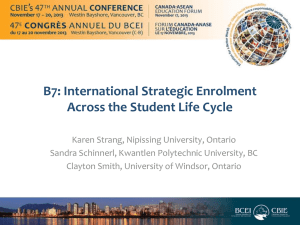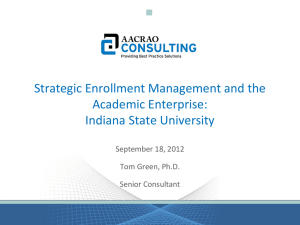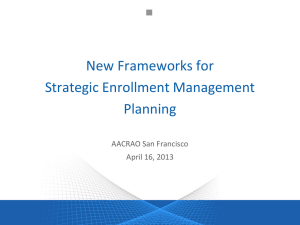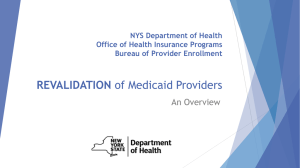SEM Planning Model - Indiana State University
advertisement
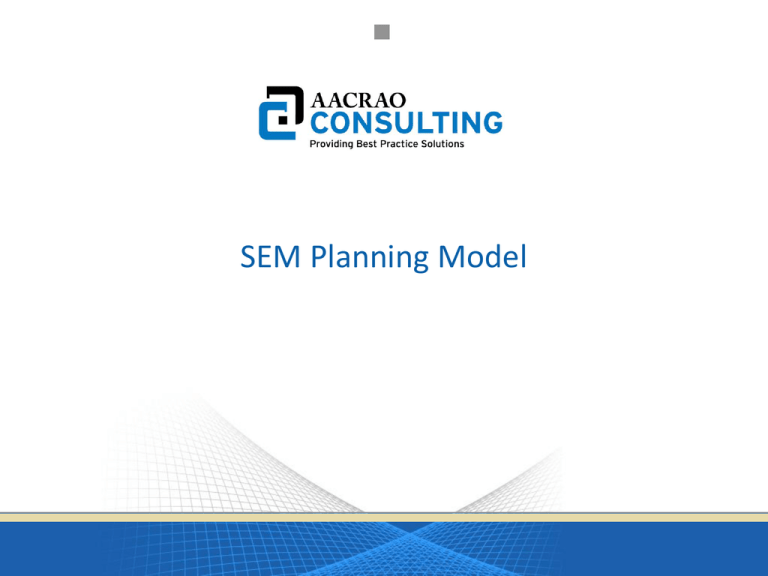
SEM Planning Model What is Strategic Enrolment Management (SEM)? Strategic enrolment management is a concept and process that enables the fulfillment of institutional mission and students’ educational goals. SEM Planning Model 2 The Purposes of SEM are Achieved by… 1. Establishing clear goals for the number and types of students needed to fulfill the institutional mission 2. Promoting students’ academic success by improving access, transition, persistence, and graduation 3. Promoting institutional success by enabling effective strategic and financial planning 4. Creating a data-rich environment to inform decisions and evaluate strategies SEM Planning Model 3 The Purposes of SEM are Achieved by… 5. Improving process, organizational and financial efficiency and outcomes 6. Strengthening communications and marketing with internal and external stakeholders 7. Increasing collaboration among departments across the campus to support the enrolment program SEM Planning Model 4 SEM Process Framework Performed by Process steps Align institutional strategic plan with broad enrollment targets and desired mix of students Develop action steps, accountability, and metrics Implement action steps Monitor progress, Report results to campus and executive leadership Mid-course adjustments New or revised goals Approve strategic goals and enrollment projection models Changes to goals Use data and information results to establish focused goals each for recruitment, retention, service, etc., and enrollment projection models Additional requests, clarifying questions Data and information gathering and assessment: Internal culture/ environment, student enrollment behaviors and scan of external environment Executive leadership, SEM Steering Committee Smaller group of staff and faculty adept at economics and data use Goals recommended by SEM Recruitment and Retention Councils; models developed by Data Team Executive leadership, SEM Steering Committee SEM councils and sub-committees Appropriate staff and faculty departments SEM Steering Committee, Chief Enrollment Officer SEM Planning Model 5 SEM Organizational Framework SEM Steering Committee Long-term enrollment goals, securing the approval of strategies through appropriate institutional channels, communication with Executive Cabinet Recruitment Council Retention Council Develop 3-4 strategic goals for new student recruitment; review and approve sub-committee action plans; recommend to SEM Steering Committee Develop 3-4 strategic goals for retention and graduation; review and approve sub-committee action plans; recommend to SEM Steering Committee 3-4 Sub-Committees 3-4 Sub-Committees Action plans, time lines and metrics for each strategic goal Action plans, time lines and metrics for each strategic goal Data Team Environment scanning, student enrollment behavior research, enrollment models, provide data to councils as needed SEM Planning Model 6 SEM Planning Framework Sustainable Enrollment Outcomes Tactics Strategies Campus Infrastructure Strategic Enrollment Goals Data Collection and Analysis Key Enrollment Indicators Institutional Strategic Plan SEM Planning Model 7 SEM Planning Framework Sustainable Enrollment Outcomes Tactics Strategies Enrollment Infrastructure Strategic Enrollment Goals Data Collection and Analysis Key Enrollment Indicators Clarity of institutional mission, vision, goals Core competencies Strategic direction Aggregate enrollment goals Institutional Strategic Plan SEM Planning Model 8 SEM Planning Framework Sustainable Enrollment Outcomes Tactics Strategies Enrollment Infrastructure Strategic Enrollment Goals Data Collection and Analysis Key Enrollment Indicators Institutional Strategic Plan Student categories: first year, transfer, graduate, certificate, continuing ed, face-to-face/online, etc. Desired student groups: racial/ethnic diversity, academic ability, special skills, family income Geographic origin: local, regional, national, international Recruitment, retention, completion Institutional capacity SEM Planning Model 9 SEM Planning Framework Sustainable Enrollment Outcomes Tactics Strategies Enrollment Infrastructure Strategic Enrollment Goals Data Collection and Analysis Key Enrollment Indicators Internal benchmarks: KEI numbers over the past 3-5 years Environmental scan − Demographics − Economics − Market opportunities − Competition Institutional research plan: designated reports and production schedule Institutional Strategic Plan SEM Planning Model 10 SEM Planning Framework Sustainable Enrollment Outcomes Tactics 5-10 year SEI targets Strategies Focus: the institution’s desired future Enrollment Infrastructure Strategic Enrollment Goals Based on: mission, data, and environmental scanning Data Collection and Analysis Key Enrollment Indicators Institutional Strategic Plan SEM Planning Model 11 SEM Planning Framework Sustainable Enrollment Outcomes Tactics Strategies Enrollment Infrastructure Strategic Enrollment Goals Staffing: skill sets, strategic deployment Systems: policies, procedures, technology Capacity for making effective enrollment decisions : positions, reporting lines, committees Data Collection and Analysis Key Enrollment Indicators Institutional Strategic Plan SEM Planning Model 12 SEM Planning Framework Sustainable Enrollment Outcomes Tactics Strategies Enrollment Infrastructure Increase new students of specified types Increase retention rates, specifically by student types Expand into new markets Utilize emerging technologies Strategic Enrollment Goals Financial aid/scholarships Data Collection and Analysis Academic programs: mix and delivery systems Key Enrollment Indicators Institutional Strategic Plan SEM Planning Model 13 SEM Planning Framework Marketing/branding initiatives Sustainable Enrollment Outcomes Academic program review Tactics Targeted interventions for students in high risk courses Strategies Enrollment Infrastructure Strategic Enrollment Goals Data Collection and Analysis Key Enrollment Indicators Institutional Strategic Plan Multilingual recruitment materials Enhanced academic advising Streamlined admission procedures Purchase a new CRM system SEM Planning Model 14 SEM Planning Framework Sustainable Enrollment Outcomes Consistently meeting goals over the long term − Enabling more effective campus-wide planning Tactics − Revisions to the institutional strategic plan Strategies − Academic planning: curriculum, faculty needs Enrollment Infrastructure Strategic Enrollment Goals Data Collection and Analysis Key Enrollment Indicators − Facility planning − Financial planning Achieving the institution’s desired future Institutional Strategic Plan SEM Planning Model 15

